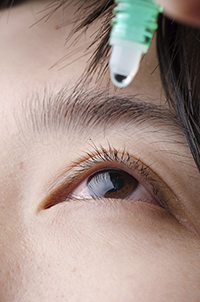Dry Eyes

What are Dry Eyes?
Dry eyes, also called keratoconjunctivitis sicca, is a medical condition caused due to a lack of adequate tears in your eyes. As a result, your eyes aren’t properly lubricated, and you may feel discomfort such as a burning or stinging sensation in your eyes.
What are the Causes of Dry Eyes?
Dry eyes are usually caused by reduced tear production by the tear glands. This can occur due to:
- Damage to the tear glands
- AgingCertain medications including decongestants, antihistamines, antidepressants, antihypertensives, anti-acne and birth control pills
- Certain medical conditions such as thyroid disorders, diabetes, Sjogren's syndrome, arthritis, scleroderma, lupus, and vitamin A deficiency
Other causes include:
- Increased tear evaporation due to constant staring at a computer screen or from wind exposure
- Ectropion eyelid where the lid turns outward
- Imbalance in the composition of the tears
What are the Signs and Symptoms of Dry Eyes?
The common signs and symptoms of dry eyes usually affect both eyes and include:
- Burning, stinging or itching sensation in your eyes
- Redness
- Light sensitivity
- Blurred vision
- Eye pain
- Difficulty wearing contact lenses
What is the Diagnosis of Dry Eyes?
Dry eyes can be diagnosed with a thorough eye exam by your eye doctor.
In addition, your eye doctor may perform a Schirmer test. This involves measuring the volume of your tears using blotting paper that is placed under your lower eyelids. After five minutes, your doctor measures the number of tears soaked up by the strip.
The quality of your tears may also be determined by using special dyes in eyedrops and examining staining patterns around the cornea and noting the time taken for the tears to evaporate.
What is the Treatment for Dry Eyes?
Treatment depends on the cause and symptoms of your dry eyes.
For mild or occasional dry eyes, over-the-counter moisturizing eye drops can be helpful.
For chronic dry eyes, you may need to consult an ophthalmologist. The different treatment therapies include:
- Oral medications, eye drops or ointments to reduce corneal or eyelid inflammation
- Eye inserts that work like artificial tears may be placed under your lower eyelid
- Tear-stimulating drugs in the form of eye drops, pills or eye gel
- Autologous blood serum drops made from your blood to treat severe dry eye symptoms that are unresponsive to other treatments
Alternative treatments include:
- Closing the tear ducts by plugging them with tiny removable silicone plugs
- Use of bandage lenses or scleral lenses that trap moisture and protect the eye surface
- Application of eye masks or warm compresses to help clear blockage in oil glands
- Intense-pulsed light therapy followed by a massage of the eyelids
Related Topics:
- Uveitis and Ocular Inflammation
- Dry Eyes
- Lid Cysts
- Blepharitis
- Glaucoma
- Retinal Tear
- Cataract
- Diabetic Macular Oedema
- Retinal Vein Occlusion
- Macular Oedema
- Cystoid Macular Oedema
- Central Serous Retinopathy
- Vision Disorders
- Watery Eye
- Tear Duct Obstruction
- Vein Occlusion
- Chalazion
- Vein Occlusion Macular Oedema
- Allergic Disorders of the Eye
- Blurred Vision
- Distortion of Central Vision
- Ocular Ischemic Syndrome
- Optic Neuropathy
- Posterior Uveitis
- Proliferative Diabetic Retinopathy
- Temporal Arteritis
- WET AMD
- Traumatic Iritis
- Acute/ Chronic/Recurrent Iridocyclitis
- Am I at Risk of Glaucoma?
- Epiretinal Membrane
- Open and Closed Iridocorneal Angles
- Pars Planitis/Intermediate Uveitis
- Retinal Detachment
- Subconjunctival Haemorrhage












